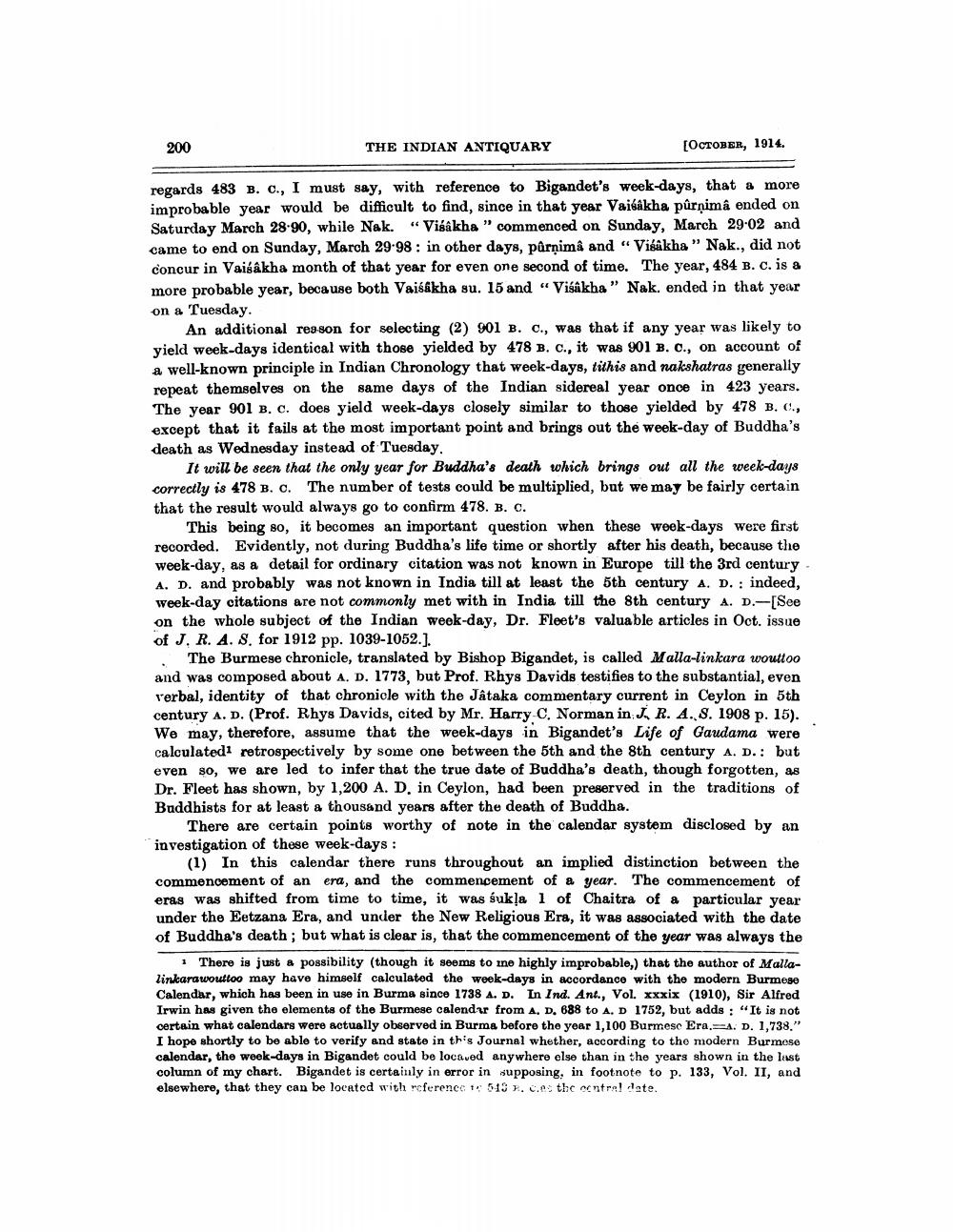________________
200
THE INDIAN ANTIQUARY
[OCTOBER, 1914.
regards 483 B. c., I must say, with reference to Bigandet's week-days, that a more improbable year would be difficult to find, since in that year Vaisakha půrnimâ ended on Saturday March 28-90, while Nak. “Visakha" commenced on Sunday, March 29-02 and came to end on Sunday, March 29-98 : in other days, parnimâ and “ Visakha " Nak., did not concur in Vaisakha month of that year for even one second of time. The year, 484 B. c. is a more probable year, because both Vaisakha su. 15 and “ Visakha" Nak. ended in that year on a Tuesday.
An additional reason for selecting (2) 901 B. c., was that if any year was likely to yield week-days identical with those yielded by 478 B. C., it was 901 B. o., on account of a well-known principle in Indian Chronology that week-days, tithis and nakshatras generally repeat themselves on the same days of the Indian sidereal year once in 423 years. The vear 901 B. c. does yield week-days closely similar to those yielded by 478 B. C., except that it fails at the most important point and brings out the week-day of Buddha's death as Wednesday instead of Tuesday.
It will be seen that the only year for Buddha's death which brings out all the week-days correctly is 478 B. C. The number of tests could be multiplied, but we may be fairly certain that the result would always go to confirm 478. B. c.
This being so, it becomes an important question when these week-days were first recorded. Evidently, not during Buddha's life time or shortly after his death, because the week-day, as a detail for ordinary citation was not known in Europe till the 3rd century A. D. and probably was not known in India till at least the 5th century A. D. : indeed, week-day citations are not commonly met with in India till the 8th century A. D.-[See on the whole subject of the Indian week-day, Dr. Fleet's valuable articles in Oct. issue of J. R. A. S. for 1912 pp. 1039-1052.].
The Burmese chronicle, translated by Bishop Bigandet, is called Malla-linkara woutloo and was composed about A. D. 1773, but Prof. Rhys Davids testifies to the substantial, even verbal, identity of that chronicle with the Jâtaka commentary current in Ceylon in 5th century A. D. (Prof. Rhys Davids, cited by Mr. Harry C. Norman in J. R. 4. 8. 1908 p. 15). We may, therefore, assume that the week-days in Bigandet's Life of Gaudama were calculatedi retrospectively by some one between the 5th and the 8th century A. D.: but even so, we are led to infer that the true date of Buddha's death, though forgotten, as Dr. Fleet has shown, by 1,200 A. D. in Ceylon, had been preserved in the traditions of Buddhists for at least a thousand years after the death of Buddha.
There are certain points worthy of note in the calendar system disclosed by an investigation of these week-days:
(1) In this calendar there runs throughout an implied distinction between the commencement of an era, and the commencement of a year. The commencement of eras was shifted from time to time, it was sukļa 1 of Chaitra of a particular year under the Eetzana Era, and under the New Religious Era, it was associated with the date of Buddha's death; but what is clear is, that the commencement of the year was always the
1 There is just a possibility (though it seems to ine highly improbable,) that the author of Mallalinkarawouttoo may have himself calculated the week-days in accordance with the modern Burmese Calendar, which has been in use in Burma since 1738 A. D. In Ind. Ant., Vol. xxxix (1910), Sir Alfred Irwin has given the elements of the Burmese calendar from A. D. 688 to A. D 1752, but adds : "It is not certain what calendars were actually observed in Burma before the year 1,100 Burmese Era=A. D. 1,738." I hope shortly to be able to verify and state in this Journal whether, according to the modern Burmese calendar, the week-days in Bigandet could be locaved anywhere else than in the years shown in the last column of my chart. Bigandet is certainly in error in supposing, in footnote to p. 133, Vol. II, and elsewhere, that they can be located with reference to 519 2. Ces the orntral date.




